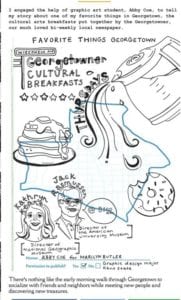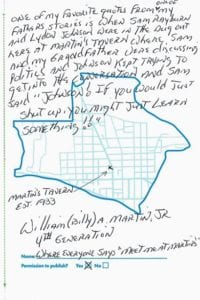Imagine falling in love with your local town. Then, dedicating all of your creative efforts to cultivating and preserving its unique culture and heritage. Georgetown resident Marilyn Butler has done (and is) doing exactly that with her “Mapping Georgetown” project.
Butler decided to capture and convey memories, impressions, family stories and details of life in Washington’s oldest neighborhood, a place she “absolutely loves.” Her goal is to publish a book of highlights to be made available in the Peabody Room of the Georgetown Public Library.
On a simple 8 ½ x 12” folded flyer with an outline map of Georgetown and a page for responses, Butler invites participants — young and old — to “reach for your pen, markers, crayons and imaginations!” and to “have fun [decorating] your map to your heart’s content.” Feel free, she adds, to “use words, pictures, vignettes, doodles and anecdotes.”
Since she launched the project in 2019, participants have returned hundreds of fascinating and historically rich responses for Butler’s collection. With life returning somewhat to normal since the pandemic, momentum on the project has picked up again and Butler is boosting the project’s social media presence.
As she does, the mapped dots and recollections begin to connect, the stories weave together, and the tapestry of Georgetown comes to life.
Butler’s own life is rich in remarkable stories. She and her husband grew up in Cleveland, but when her sons came to college here., they travelled frequently between Georgetown and Ohio. After their first grandchild was born, she found a “beautiful” area for a Georgetown apartment “kitty corner across the street from Dumbarton Gardens,” she told The Georgetowner.
In Cleveland where she grew up and still has a home, her father, a “defense attorney of 50 years” was “taught how to swim by Elliot Ness” at the beach near their home. In their family kitchen “Mrs. Stouffer made her apple pies” and “took them on the trolley car to their restaurant on Public Square.” And, the “whole Stouffer empire started from there.”
Connecting people has always been a theme in Butler’s life. With a degree in business — or as she calls it “a degree in survival” — Butler became an early pioneer in the cell phone industry helping provide for her family of six. Eventually she retired as an executive from AT&T.
While working at AT&T, she became a docent at the Cleveland Museum of Art in her spare time. She came to love seeing details people observed in the artworks, hearing people’s stories, and delighting in the creativity of the artists showcased. Learning more and more about the exhibits and the way viewers perceived them was a “wonderful feeling,” she said. “I loved it… My [docent] tours had stories attached to them. And, I would start out and say “what do you notice in this?” I would tell any stories I had… and we’d discuss the time period … It was really fun…. And it evolved.”
Always interested in photography, Butler took a Photoshop class from the museum. When in Georgetown, she began connecting with people through her photography. After buying an art piece from a Georgetown shop, the owner invited Butler to try to sell a framed photo she took of a rowing crew seen from Key Bridge. Before her family members could visit the store to see the photo on sale it sold for over $1,000.
In love with Georgetown’s neighborhoods, she created a poster collage of “Georgetown Doors” which sold well. When she took the poster to donate to the Georgetown Public Library, she met Jerry McCoy, the Special Collections Librarian/Archivist at the Peabody Room. Given Butler’s interest in photographing Georgetown, McCoy showed her a book entitled “Georgetown Panorama.” Published by the U.S. Commission of Fine Arts in 1977 to be used by the Old Georgetown Board, the accordion-style book of collaged photographs captures the full architectural streetscapes of both M Street and Wisconsin Ave. in Georgetown.
According to Butler, McCoy said “what he really wanted to see” was an updating of this work since he considers it to be a highly “pivotal and important pictorial reference tool.”
To McCoy’s surprise — since two other photographers had not followed through on his same suggestion — Butler saw the project to completion.
McCoy was awestruck by what Butler eventually produced, a self-published volume “M Street: A Georgetown Panorama.” Butler’s book outshone the original black-and-white work from 1977, McCoy told The Georgetowner. “I was absolutely stunned as to what she had done. She really followed the layout of the original work… She did an amazing job of weaving the pictures together. I was speechless. She did all this as a donation [to the library]. She took all the photographs and did just a stunning and beautiful job. What she created will become as important as the original work to future generations of researchers… And, she did it all out of her love of Georgetown.”
Butler’s intensive photographic work on the Georgetown Panorama project connected her intimately to her neighbors and passersby and set the stage for Mapping Georgetown. “People would stop me on the street and say ‘I saw you on M Street taking pictures,” she said. “In the process of this labor of love project… I talked with a lot of people and it just grounded me in the neighborhood.”
Soon, a store cashier asked her to design another Georgetown poster he could display near the cash register. As she considered the project, she had a vision that the best way to bring Georgetown to life was to focus on the personal connections she loved to make with the people in the neighborhood. On a trip to Russia, she had met someone who described the joys of story-mapping and she had seen a Mapping Manhattan storybook. “You know, mapping is a thing,” she told us. So, the Mapping Georgetown project was born.
As Butler began handing out her story-map cards to the “friends of Georgetown” she met, she used her docent skills to prompt free-flowing and on-the-spot responses. “People are often intrigued,” Butler said, “They say ‘what is this?’ So, I talk to them about it and usually in the conversation they’ll tell me something, so I say ‘there’s your story right there’…. I’ve had many people who’ve handed me back Georgetown stories say ‘I’m so glad you asked me to do this because I haven’t thought about [this] and I’ve really enjoyed putting it together and writing about it.’”
In January, 2020, the Washington Post got wind of Butler’s Mapping Georgetown project and highlighted her community activism in historic preservation. “Marilyn Butler is one of [Georgetown’s] residents committed to cataloguing the area’s happenings….
“Without a doubt, hands down, what I like most about Georgetown is the people,” Butler told the Post. “Everyone I’ve met has led me to someone else and the experience of it has been magical.”

And now the Georgetown stories are flowing in — gathered by Butler in-person, through the mail or via email.
From Billy Martin of Martin’s Tavern: “One of my favorite quotes from one of my father’s stories is when Sam Rayburn and Lyndon Johnson were in the dugout here at Martin’s Tavern where Sam and my grandfather were discussing politics and Johnson kept trying to get into the conversation and Sam said “Johnson, if you would just shut up, you might just learn something!!” Signed: William (Billy) A. Martin, Jr., 4th Generation
Butler tells the one about Julia Child, Katharine Graham and Pamela Harriman. “Well, the story is that Julia Childs lived in that house and she and Pamela Harriman and Katharine Graham didn’t know how to cook. So, they started making pot luck dinners and they got pretty good at it and look where it took Julia Childs.”
One story describes a writer’s mom whose “Great Great Grandfather” told stories of riding on the horse-drawn trolley car from Georgetown to the White House along with president Lincoln’s son Robert who was a frequent rider.
Another Georgetown resident and author of “Unconditional Surrender: The Romance of Julia and Ulysses S. Grant” pinpointed on the map the “final resting place of Emma Dent Casey who is interred in the lovely Oak Hill Cemetery.” Casey’s writings helped give the writer “insight into the love affair of Mr. and Mrs. Grant.”
One respondent recalled the joys of archeological research at the home site of Yarrow Mamout, one of Georgetown’s most historically significant African American residents. “As a volunteer with the DC Preservation Office’s Archeology Team, I had the privilege of helping with the excavation of the Yarrow Mamout home site. I have fond memories of the work, and my time in Georgetown!”
An eyewitness to the fire that nearly burned down the Georgetown Public Library in April, 2007 tells her story. “At the corner of R and Wisconsin, NW, I watched the original flames come from the roof the day of the Georgetown DCPL fire. A small crowd had gathered and I joined them as we anxiously awaited the arrival of fire trucks…” This map-story connected several dots for Butler. Much to McCoy’s relief, the Peabody Room’s beloved portrait of Yarrow Mamout had been rescued from the conflagration.
Butler contributed one of her own stories — an article about the racial integration of Holy Trinity School. She had written up an interview for the school about Adele Dodson, the school’s first Black student.
Some of the most touching stories describe Georgetown’s daily life. “This is a special Georgetown gem — we all know each other and care — singles, couples, families with babies and children — We share each others’ walks, blow leaves and water plants — If you drive down too fast, you’ll miss the magic,” wrote Judith Burnell. One child was particularly proud of her grandfather who works at Georgetown Cupcake and she included a little cupcake drawing.
 “Everything leads to something else. So, whatever interests you have, there are unlimited opportunities for stories and for relationships,” Butler said.
“Everything leads to something else. So, whatever interests you have, there are unlimited opportunities for stories and for relationships,” Butler said.
Meanwhile, at the Peabody Room, McCoy is looking forward to putting the Mapping Georgetown collection on display. In addition to the bound volume, he would like to feature Georgetown story highlights on the digital collections page (DigDC) of the D.C. Public Library.
“I’d really like to see a Marilyn Butler in all the other neighborhoods of D.C. doing something similar,” McCoy said. “It’s such important information to capture. They’re like little miniature oral histories… It’s really a neat thing she’s doing.”
To participate in the Mapping Georgetown project, go to https://mappinggeorgetown.com/, visit “MappingGeorgetown” on Instagram or pick up a flyer from the Georgetown Public Library.
Stay tuned! In forthcoming issues, The Georgetowner will be working with Marilyn Butler to bring stories from the “Mapping Georgetown” project to light. We’ll also be running our own graphic features on people who have lived in Georgetown in the past as well as those who live here today.



Sooooooo excited to hear what you are doing. As a fifth generation Washingtonian who grew up at 3307 O st, my love for this city continues. Would love to participate in your project. If you could, we could do lunch at Martin’s. I’ll ask Billy to reserve booth 6 for us. Hope to hear from you. 2028417787. Marianne Hawk Brennan.
Left you a message with no response. Mmmmmmm
I love this Beautiful Georgetown. I have Great clients here, I worked
in this area for over 40 years. We do Draperies, Upholstering, Refinishing, Furnishings and Interior Designing